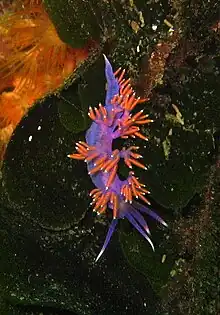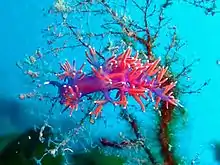| Paraflabellina ischitana | |
|---|---|
 | |
| Scientific classification | |
| Kingdom: | |
| Phylum: | |
| Class: | |
| (unranked): | clade Heterobranchia clade Euthyneura |
| Superfamily: | |
| Family: | |
| Genus: | |
| Species: | P. ischitana |
| Binomial name | |
| Paraflabellina ischitana Hirano & Thompson, 1990[1] | |
Paraflabellina ischitana is a species of sea slug, an aeolid nudibranch, a marine gastropod mollusk in the family Flabellinidae.[2]
Etymology
The name ischitana means from Ischia, the island from where this nudibranch was first named.[3]
Distribution

This species is found in Mediterranean waters around Spain in such locations as Costa Brava,[4] and in the Tyrrhenian Sea, especially around Ischia (hence the species Latin name).[3][5][6]
Habitat
Paraflabellina ischitana usually can be found in shallow water, but it can also reach depths of 35 m.[3]
Description
This species can grow to a length of approximately 4 cm and is mostly purple-violet in colour. It has opaque white-tipped certa, rhinophores, and oral tentacles. The rhinophores are annulate.[7] Due to the somewhat transparent skin of the ceras, the branches of the digestive gland are visible, and appear as red-orange.[3][5][6][8][9][10]
Similar species
Paraflabellina ischitana is often confused with Flabellina affinis, but can be distinguished as follows:[3][6]
- Paraflabellina ischitana: the ceratal surface has no purple-violet colouration and is translucent;
- Flabellina affinis: the digestive gland is not visible as the area beneath the subapical white ring is opaque;
Paraflabellina ischitana is also similar to Edmundsella pedata, but they can be distinguished on the basis of their rhinophores:[7]
- Paraflabellina ischitana has annulate rhinophore
- Edmundsella pedata has smooth or papillate rhinophores
Biology
This nudibranch likely eats hydroids of the genus Eudendrium (Eudendrium racemosum and Eudendrium glomeratum) as its main food source.[3][5][8]
Like other nudibranchs, this species is hermaphrodite. Mating occurs in late spring.[6] The egg case is whitish or reddish,[8] with thousands of eggs of about 70 microns. The nudibranch places the egg case on the branches of hydrozoa.[6]
Bibliography
- Egidio Trainito, Nudibranchi del Mediterraneo. Guida al riconoscimento dei molluschi opistobranchi, 2005ª ed., Milano, Il Castello, 2005, ISBN 88-8039-438-X.
- Gary R. McDonald, University of California Santa Cruz - Nudibranch Systematic Index, University of California Santa Cruz - Institute of Marine Sciences
References
- ↑ Y.J. Hirano & T.E. Thompson, 1990. Flabellinid nudibranchs from the Bay of Naples, with a description of a new species, Flabellina ischitana. Journal of Molluscan Studies, vol. 56, p. 345-354
- ↑ MolluscaBase eds. (2020). MolluscaBase. Paraflabellina ischitana (Hirano & T. E. Thompson, 1990). Accessed on 2020-08-27.
- 1 2 3 4 5 6 Manuel Ballesteros, Enric Madrenas, Miquel Pontes et al.,«Flabellina ischitana (Hirano & Thompson, 1990)»
- ↑ "Mer et littoral - photographie de Flabellina ischitana - # - Biologie des Mollusques". Mer-littoral.org. 2007-07-01. Retrieved 2012-07-05.
- 1 2 3 Christian COUDRE. "Flabelline d'Ischia, Flabellina ischitana". Cotebleue.org. Retrieved 2012-07-05.
- 1 2 3 4 5 Sylvain Le Bris, Michel Péan « Flabellina ischitana Hirano & Thompson, 1990 »
- 1 2 Nembro
- 1 2 3 "Flabellina ischitana | Animalandia". Herramientas.educa.madrid.org. Retrieved 2012-07-05.
- ↑ Rudman, W.B. "Flabellina ischitana". The Sea Slug Forum. Archived from the original on 2010-06-15. Retrieved 2012-07-05.
- ↑ "Photo of Flabellina ischitana - # - Mollusc biology". European Marine Life. Retrieved 2012-07-05.
External links
 Media related to Flabellina ischitana at Wikimedia Commons
Media related to Flabellina ischitana at Wikimedia Commons- Photos of Paraflabellina ischitana on Sealife Collection